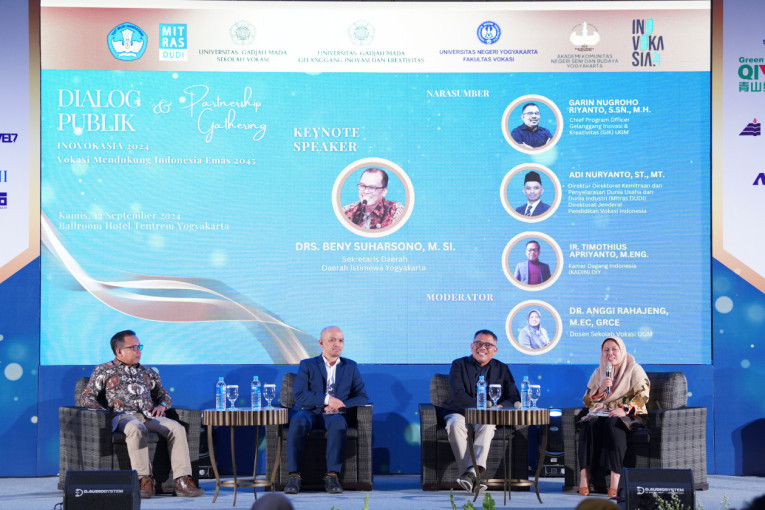
The gap between the education system and industry remains significant. The competencies of graduates required by industries are still not adequately met by Indonesia’s educational system.
Vocational schools were established to bridge this gap. Furthermore, industry players are becoming involved in vocational education to help build a job-ready workforce.
This issue was highlighted during the INOVOKASIA Public Discussion and Partnership Gathering titled “Vocational Education for a Golden Indonesia 2045,” which took place at the Tentrem Hotel, Yogyakarta, on Thursday (Sep. 12).
The public discussion, organized by UGM and UNY’s Vocational Schools, featured several speakers, including Garin Nugroho, director and Artistic Director of UGM’s Innovation and Creativity Hub (GIK UGM).
Another speaker was Adi Nuryanto, Director of Partnership and Alignment between Education and Industry at the Ministry of Education, Culture, Research, and Technology, and Timothius Apriyanto, Secretary of the Indonesian Chamber of Commerce (KADIN) for the Special Region of Yogyakarta (DIY).
Nugroho shared his views on vocational education and industry from the perspective of an artist and cultural figure. According to him, many jobs in Indonesia remain low-skill, making competing with artistic works from other countries difficult.
He also mentioned how the United States has implemented large-scale skills training from elementary to high school.
“To reach a high-skill level, the foundation is character, education, and training,” Nugroho said.
Nuryanto revealed that there is currently a gap between the education system and industry, as the competencies of human resources required by industries are still not being fulfilled by the educational system in Indonesia’s universities.
“This is where vocational schools come in, to bridge that gap,” he stated.
Meanwhile, Apriyanto emphasized that vocational education must also consider the transformation of the digital industry. The development of artificial intelligence (AI) is projected to cause 14 million people to lose their jobs, with even more workers expected to be affected.
“There needs to be a transformation from low-cost industries to creativity-based industries,” he explained.
In her opening remarks, UGM Vice-Rector for Education and Teaching Professor Wening Udasmoro stated that vocational education plays a crucial role in driving industrial progress in the country.
Professor Udasmoro appreciated the commitment of industry partners who collaborated with UGM’s Vocational College (SV UGM) to support graduates’ competencies to meet industry needs.
“The collaboration between vocational education and industry forms a strong foundation for creating a Golden Indonesia in 2045,” Professor Udasmoro said.
The Regional Secretary of DIY, Beny Suharsono, also attended the event and delivered a keynote speech on the importance of human resources development in the transformation from Industry 4.0 to Industry 5.0.
According to him, vocational schools in DIY must integrate and strengthen partnerships to face the challenges of the revolution in the post-industrial era.
“Industry players must also participate because improving the quality of workers will directly impact the industry itself,” Suharsono concluded.
Author: Tiefany
Editor: Gusti Grehenson
Post-editor: Afif

